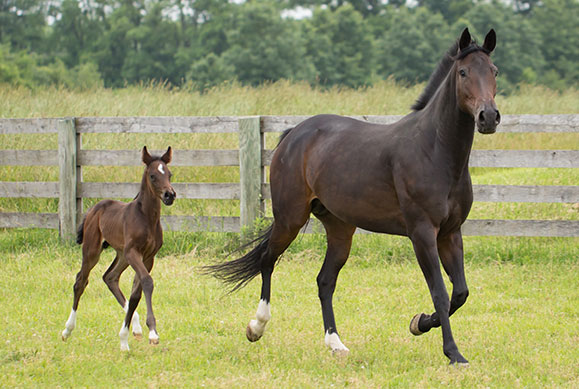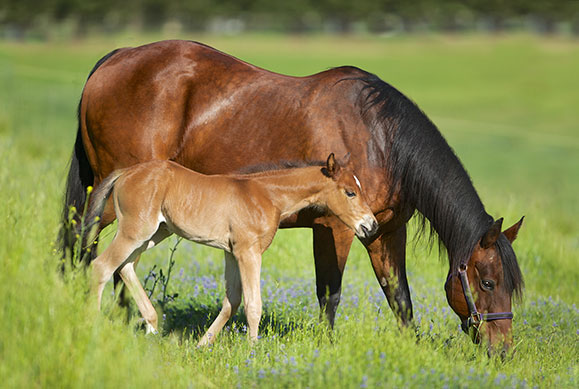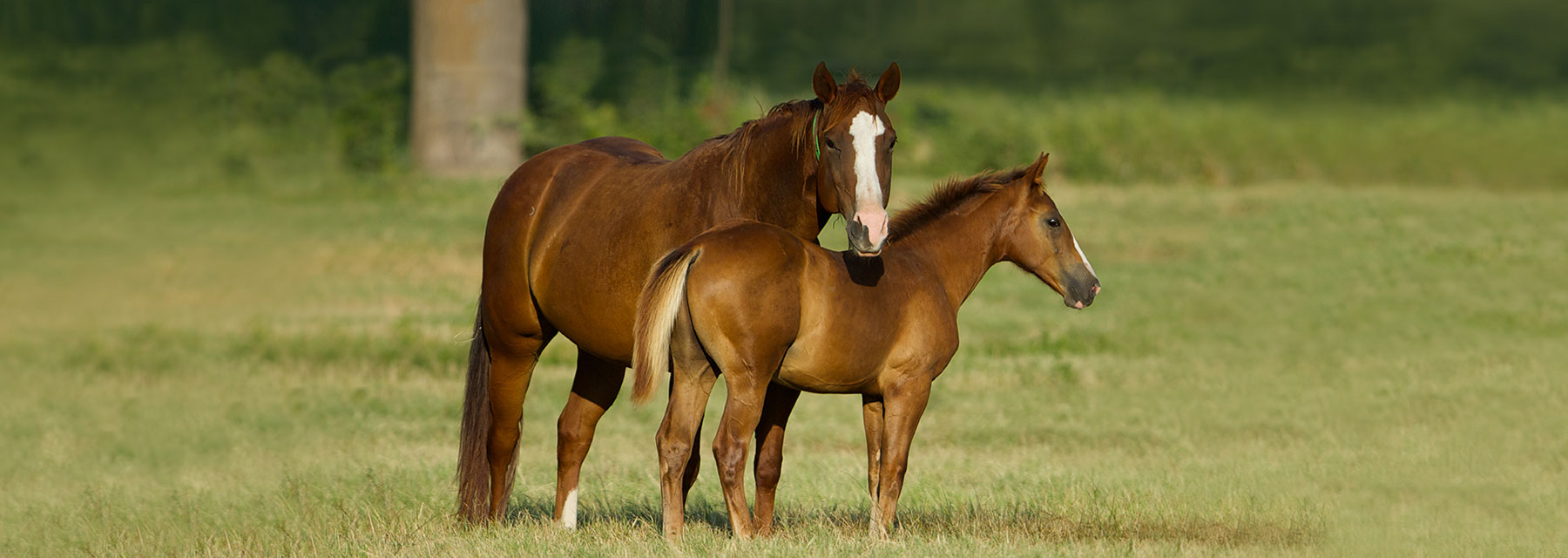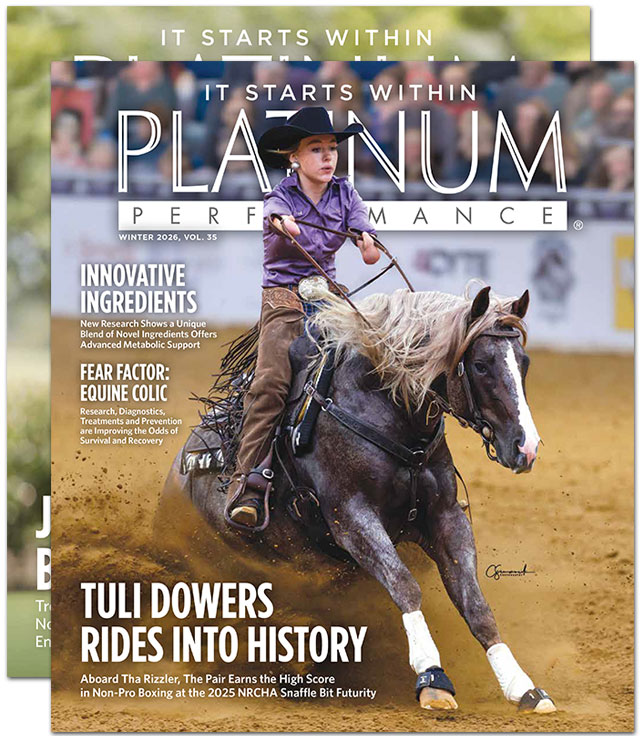Management and Dietary Considerations for Mares and Stallions Throughout All Stages of Reproduction
Healthy foals come from healthy horses. Providing optimal nutrition for broodmares and stallions should not be complicated. Maintaining a healthy body condition based on a forage diet with supplementation to fill in nutrient gaps will set up every stallion, mare and foal for success.
Support for the Mare
In Disney’s 2010 beloved horse movie, Secretariat, housewife turned first lady of Thoroughbred racing, Penny Chenery says, “Stallions cost more than mares; they’re more glamorous. But Daddy knew that a great horse comes just as much from the mare as the stallion.” The health of the foal relies significantly on the health of the broodmare, and nutrition is a critical factor. What the mare consumes directly influences the growth and development of the foal both in utero and after parturition. Proper care and management of the mare not only affects the developing foal but also that of the mare. Healthy mares kept in good body condition have been shown to have improved conception rates and shorter rebreeding cycles. It is a very worthwhile undertaking to keep the broodmare healthy and happy throughout all the stages of reproduction — maintenance, gestation, lactation, rebreeding — and everything in between.
She’s in Good Condition
Feeding the broodmare should not be difficult. In fact, basic and straightforward is usually the best way to feed every horse, including gestating mares. One of the easiest strategies is to aim to feed in a way that maintains a healthy body condition and make adjustments as needed to keep her in good weight. Body condition scoring (BCS) is widely accepted as an important health monitoring system for any horse and is a useful tool to help gauge weight and condition of breeding horses — before, during and after breeding season. For the broodmare, it can make it easier to assess and keep track of body condition changes throughout the breeding season and help determine when feeding adjustments are necessary. The commonly used Henneke BCS system is based on a 1 to 9 scale, with 1 being emaciated and 9 being obese. Most experts recommend maintaining broodmares in a body condition between 5 and 6 (moderate to fleshy), staying toward the higher end when entering breeding season and — more importantly — into late gestation. This ensures mares have body stores available to support rapid fetal development, foaling and lactation.
Body condition can affect reproductive efficiency. A body condition score of 5 or above is recommended for optimal reproductive efficiency — mares cycle earlier, take fewer breedings to conceive and have a higher conception rate than thin mares. Malnourished or very thin mares are also more likely to abort an early embryo. Nutritionally deprived broodmares tend to have longer pregnancies due to an inadequate attachment of the placenta within the uterus. This can increase the amount of time the fetus requires to get essential nutrients in order to grow.
Conversely, obesity can also negatively influence fetal development by impacting placental function and affecting nutrient transfer to the foal in utero. Compared to thin mares or mares kept at an ideal body condition, obese mares may have more difficulties foaling and may produce less milk. Obese broodmares can be predisposed to metabolic issues with reduced glucose tolerance and reduced insulin sensitivity. Keeping the broodmare in good weight before, during and after gestation is ideal and will make sure mare and foal are set up for continued health.
Body Condition Scoring Chart
The commonly used Henneke BCS system is based on a 1 to 9 scale, with 1 being emaciated and 9 being obese.
1

Poor
2

Very Thin
3

Thin
4

Moderately Thin
5

Moderate
6

Moderately Fleshy
7

Fleshy
8

Fat
9

Extremely Fat
What is a “concentrate?”
A “concentrate” is a feed that provides a condensed or concentrated source of calories. Examples include cereal grains like corn, oats and barley, as well as commercial mixes and fortified sweet feeds and pellets. Concentrates are typically added to a horse’s diet to add energy or calories to maintain or gain weight or support exercise intensity. When needed, concentrates should be used as a complement to forage. For broodmares, concentrates are added when the forage portion of the diet does not provide enough calories to maintain an ideal body condition. They are often used in late gestation and/or early lactation to help the mare stay in a healthy weight range.
Feeding the Broodmare
There are several areas during pregnancy on which nutrition projects an important influence. First are the requirements needed by the pregnant mare to maintain her own body. Then, there are the nutrients above the mare’s own requirements that are needed to synthesize fetal tissue. The creation of accessory tissues of conception that include the placenta, the augmenting of the uterus, and enlarging and prepping the mammary glands for lactation will increase nutrient requirements. Lastly, it is a huge nutritional toll to produce milk for the foal. Providing the mare with a forage-based balanced diet is a simple, preventative way to set up both her and her foal for health and well-being.
Like all horses, broodmares thrive on forage — and many do fine on quality forage alone from start to finish. Good quality pasture and hay should make up the majority of the diet throughout all stages of pregnancy and into lactation. Broodmares should be fed as much forage as needed — free choice if possible — to maintain a healthy body condition, and supplemented with concentrated feeds if additional calories are needed. For most horses, including broodmares, it is recommended to minimize concentrated feeds that often contain high starch and sugar levels. High amounts of starch and sugar are associated with several equine health issues, including metabolic issues, digestive disturbances and colic. The higher the quality of forage fed, the lower the amount of concentrate will be necessary to meet nutrient needs. Feed the smallest amount of concentrate needed to maintain the mare within the 5 to 6 body condition range. If she can maintain her weight on forage only, then it is not necessary to feed her a concentrate. A daily comprehensive omega-3 fatty acid, vitamin and trace mineral supplement is recommended to complement the forage and fill in any nutrients that may be lacking. Plain, white salt and fresh water should always be available.
Did You Know?
- Normal gestation ranges from 320 to 360 days (11 months)
- 65% of total fetal growth happens in the final trimester
- In early lactation, a mare produces 44 pounds of milk/day
- During lactation, water consumption will increase up to 24 gallons per day
The No Fuss Broodmare Diet
A common mistake when feeding a mare in foal is to overfeed grain or concentrate (calories) and underfeed vitamins and minerals.
The following no fuss diet will keep feeding your broodmare simple.
Pasture: If you have it, use it. Fresh pasture provides high fiber and several vitamins in their natural, most bioavailable form like beta carotene and vitamin E and offers an ideal ratio of omega-3 fatty acids.
Hay: Use a good quality grass hay that is less than a year old and provide it free choice.
Alfalfa: An excellent source of protein and calcium, alfalfa is great to blend with a quality grass hay to provide additional nutrition to mare and developing foal.
Vitamins and minerals: Use a comprehensive vitamin and mineral wellness supplement from the get-go. Broodmares can remain on one all year, but this is especially important when they are gestating and lactating. Pregnant mares without access to pasture will likely need to be supplemented with vitamins A and E. Selenium is another very important mineral for a broodmare. It has a narrow safety margin and may be worth having a hay analysis done to know if supplementation is needed. Remember to add all sources together — pasture, hay, concentrates, supplements, etc. — to decide whether selenium supplementation is needed.
Omega-3 fatty acids: Important for the health of every mare but especially for those without access to pasture. Provide a source of omega-3 fats throughout gestation and lactation.
Salt: Plain, white and always available.
Concentrates: If extra calories are needed to maintain body condition, such as during lactation, look for a fortified feed designed for broodmares or mares and foals. Reputable companies will take into consideration the mare’s needs in addition to those of the developing foal and likely will include quality sources of protein and balanced levels of vitamins and minerals.
The Nutritional Demands On the Mare: Gestation Through Lactation
Gestation: Conception to Month 5
Normal equine gestation ranges from 320 to 360 days or about 11 months. During the first several months of pregnancy, nutrient needs do not change significantly above maintenance requirements. However, it is important to make sure that those maintenance requirements are actually being met to support hormonal balance and early fetal growth. For the first half of gestation, fetal development is slow — approximately 0.2 pounds per day — but it is still a critical growth period. For early to mid-gestation, good-quality forage will likely meet energy and protein requirements and feeding concentrates may not be necessary unless weight gain is needed to get to a healthy weight. These nutrient requirements begin to increase around month five and continue to rise throughout gestation and into lactation.
In the early gestational months, typical feeding recommendations are similar to a maintenance life stage level of approximately 1 megacalorie per pound of feed. For an average-sized 1,100-pound mare, this is approximately 15 to 22 pounds of forage depending on the roughage quality and the mare’s individual metabolism. A balanced, forage diet that provides high-quality protein and amino acids with a comprehensive vitamin and mineral supplement and a source of omega-3 fatty acids is an excellent way to support broodmare and early foal development.
In the early gestational months, typical feeding recommendations for an average-sized mare are approximately 15 to 22 pounds of forage depending on its quality and her metabolism.
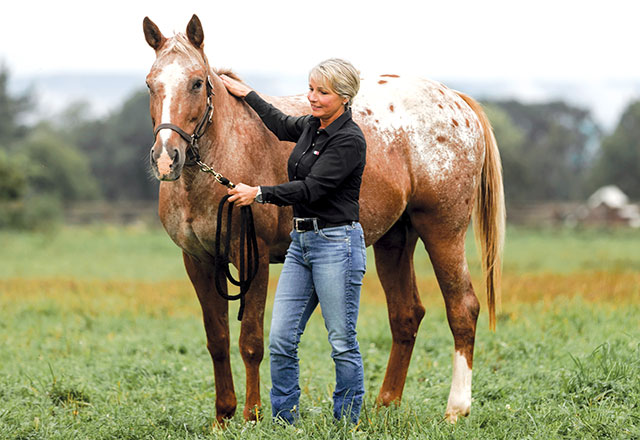
PHOTO BY ELIZABETH HAY PHOTOGRAPHY
Gestation: Month 6 to Foaling
The second half of gestation requires more focus on nutrition as the mare will now need to sustain her body while nourishing a more rapidly-growing foal in utero. Continue to feed to the ideal body condition — fleshy not fat. At this point, the mare will likely need on average 10 to 20 percent more calories and higher levels of protein and amino acids to support fetal growth as well as moderate increases in some vitamins and minerals. If the mare has been maintained on a forage-only diet up to this point and continues to hold her weight well, consider adding a comprehensive omega-3 fatty acid, vitamin and mineral supplement or a balancer pellet to meet the increasing nutrient demands. If the mare requires more calories than what forage can provide, add a concentrated feed or flaxseed oil to increase energy in the diet. If the mare is consuming more than four to five pounds of a fortified concentrate daily, a balancer pellet is not necessary as micronutrient needs will likely be met by that level of concentrate fed.
In the last 90 days of gestation, the foal will double in size with about 65 percent of total fetal growth happening in the final trimester. During this time, the mare will gain about one pound per day. Total gestational weight gain is typically around 12 to 16 percent of the mare’s pre-pregnancy body weight. As she approaches the end of gestation, several nutrients will be required in moderately-higher levels than those of maintenance requirements. Calories and energy will be needed to maintain her weight and support the growth of the foal. Protein and amino acids will support fetal tissue development and prepare reserves for the significant drain of lactation. Calcium, phosphorus and magnesium are required in balance and need to be available from the diet to support bone and soft tissue development. Copper, another critical development mineral, is used for healthy fetal skeletal and cartilage tissue. Mare’s milk is basically devoid of copper, so the mare provides it to the fetus in utero to support growth. The antioxidant vitamin E increases passive transfer of antibodies from mare to foal, a significant immune benefit. During this second half of gestation, broodmares may eat slightly more hay given the choice, nearly 2 to 2.5 percent their body weight that will help cover the spread of the increased nutrient requirements. A good general guideline to follow is to provide a good quality 40/60 alfalfa/grass hay mix or blend free choice with one to two pounds of a 30 percent protein balancer. Remember that the higher the quality of forage, the lower the amount of concentrate will likely be needed to meet nutrient requirements.
As the mare approaches the very end of gestation and is close to foaling, she may back off feed (hay included) as her body is literally running out of room as the size of the foal increases. Providing enough nourishment to the mare during this time is essential as underfed mares that lose significant weight can have decreased colostrum and a reduction in milk production. Continue to provide free choice quality hay. Concentrated feeds can often be helpful at this point as well as healthy oils, like flaxseed oil, to supply calories if needed. Providing a balanced diet that meets the nutritional demands of late gestation is critical for the mare as she will rely on these reserves to recover from the stress of foaling and as she begins lactation — as well as to prepare for rebreeding in some cases.
“Nutrition allows us to help the entire horse, and it’s one of our most important methods. There is more and more great research coming out regarding the benefits of nutrition, particularly omega-3 fatty acids and antioxidants.”
— Dr. Charlie Scoggin, Rood & Riddle Equine Hospital
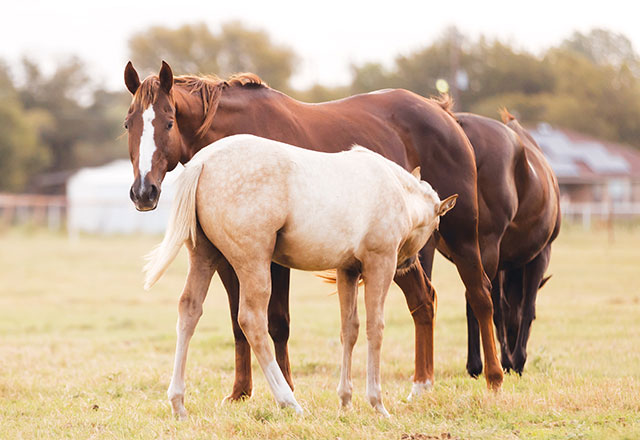
Lactation
After birth, nutrition for the new foal is straightforward. Mare’s milk is perfectly tailored for healthy, steady foal growth and provides necessary energy, protein and other essential nutrients. However, to provide this “liquid gold” requires an incredible amount of bodily effort from the broodmare. Lactation is the most nutritionally-demanding equine life stage, and feeding adjustments will likely be necessary to provide enough quality nutrition to support her energy and protein requirements. Interestingly, even if provided insufficient nourishment, the mare’s milk composition and production will not suffer. The mare’s body will mobilize its own tissue stores to make up for nutritional shortcomings.
Nutrient requirements of the lactating broodmare increase significantly to facilitate milk production. Energy requirements almost double. A mare in early lactation (about the first two months) is capable of producing 3 to 4 percent of her body weight in milk — that is up to 44 pounds of milk per day for an 1,100-pound mare. Because milk is predominately water, providing plenty of fresh, clean drinking water during lactation is a must. Water consumption may increase up to 24 gallons per day.
The mare in early lactation will likely require 2.5 to 3 percent of her body weight in total feed daily. For an average mare, this is between 27.5 and 33 pounds of feed per day. Provide consistent access to good grass hay. If not fed previously, adding alfalfa to the lactating mare’s diet is advocated. It is a higher energy hay and an excellent source of amino acids with great levels of calcium—all things the lactating mare needs at higher levels while producing milk. Again, if your mare can maintain a healthy body condition on quality hay and balancing supplements, that is a perfectly healthy way to feed her. However, lactating broodmares may require some amount of concentrated feed to maintain an ideal body condition. If introducing a concentrate for the first time or if the mare went off feed at the end of gestation, introduce a small amount gradually, over seven to 10 days, building up to the target amount to avoid digestive disturbances. Use a healthy flaxseed oil to bring fat into the diet. Fats and oils provide over twice the calories that an equivalent amount of carbohydrates or proteins do. This can be helpful for hard-keeping mares and those that lose significant weight during lactation. The mare’s body is the best way to easily know if she is consuming enough calories.
After three or four months, milk production will begin to gradually taper off as the foal decreases nursing time and begins to graze and take interest in other feeds. Once the foal is weaned, usually between four and seven months, the mare’s nutrient requirements will then return to maintenance or pre-pregnancy. If she is already rebred, her requirements will be that of early gestation.
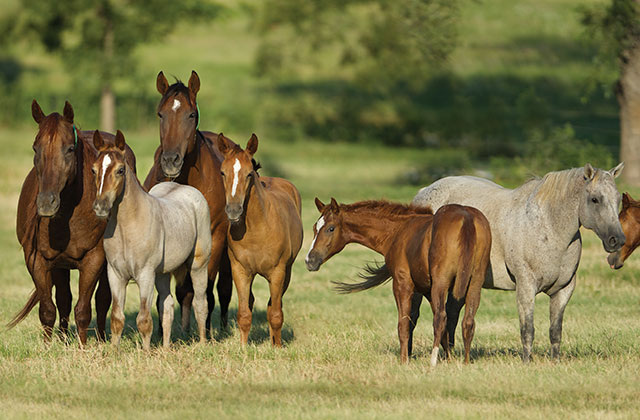
PHOTO BY CAM ESSICK
Did You Know?
An average-sized 1,100-pound lactating broodmare can increase water consumption up to 24 gallons per day and require between 27.5 and 33 pounds of feed daily, which is almost double her normal energy requirements.
Thinking Ahead: Maintenance for Barren Mares
Barren mares, maiden mares and mares at maintenance that are not pregnant or not just coming off of a pregnancy can sometimes be a little bit of an afterthought. If you are planning to breed a mare, it can be beneficial to think ahead. If the mare has been living out on pasture and will be pulled in at the beginning of breeding season, she may or may not be in tip-top health and body condition.
Mares that have lost significant weight may have even stopped cycling. It is worthwhile to take time before breeding to feed them to an ideal body condition at or above BCS 5, so she can begin breeding season in good health. Focus on body condition and work to get her to that ideal a couple months in advance, so there is time to gain or lose weight at a slow and healthy pace. This is also a good time to request that your veterinarian pull a blood sample and check that everything looks normal and in a healthy range.
Supplement mares with a comprehensive wellness formula that includes omega-3 fatty acids, vitamins, minerals, amino acids and antioxidants to ensure these essential nutrients are available for conception. Start her on a pre- and probiotic to promote a healthy hindgut and support immunity.
Have forage analyses done on your pasture and hay to know if any nutrients are low or depleted that need to be specifically supplemented during gestation.
Support for the Stallion
For most breeding stallions, there are two annual stages — the breeding season and the off-season. In the United States, breeding season is usually about five-months long spanning from January or February through June or early July. There are a wide range of breeding duties depending on the stallion, breed, discipline and geography. Some stallions only breed a few times a year. Other stallions in artificial insemination programs may be expected to mount a phantom once a day, three or four times a week. Some popular live cover thoroughbreds may mount two to three times per day, breeding more than 150 mares during the season. Still other stallions pull year-round breeding duties, covering over 300 mares per year. What is consistent in each breeding situation is that the stallion will rely on a healthy diet to provide the nutrients needed for optimal health and to breed appropriately.
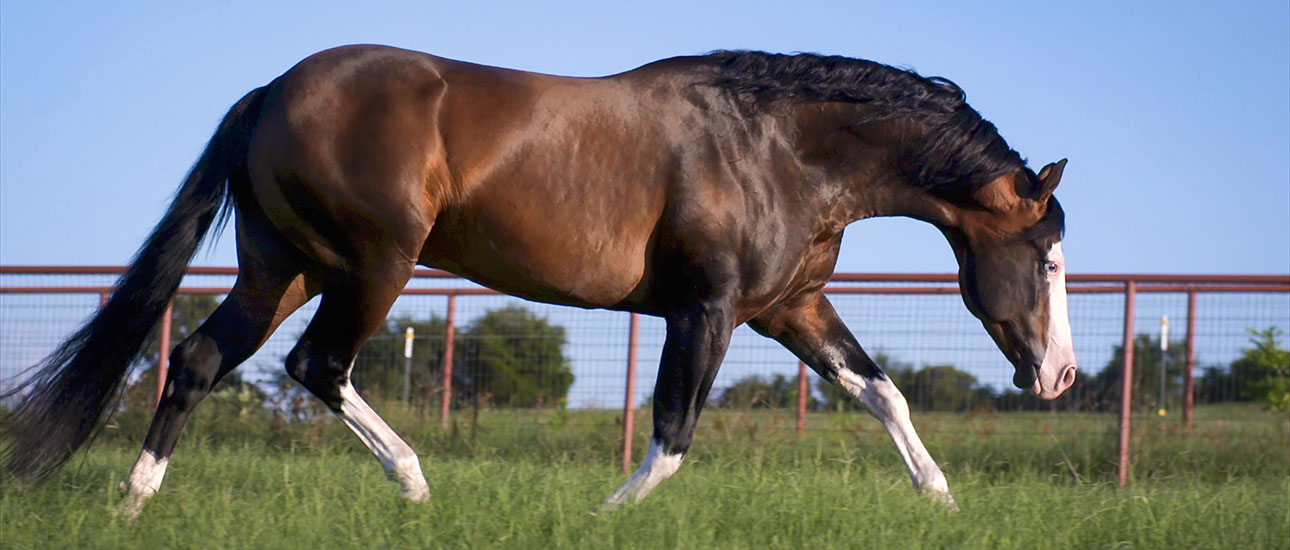
Feed the Individual
Because of a wide variation in workload, an important thing to remember when feeding the stallion is to feed on an individual basis. Every stallion requires a balanced, forage-based diet. But many things affect his individual daily energy or calorie requirements — age, body condition, general health and metabolism, exercise and breeding frequency. The horse’s disposition may also be a main factor. Some stallions are calm and unbothered by breeding work. Others nervously pace the fence line, pawing and are generally anxious expending calories for months on end through this type of behavior. Stallions typically require more calories than geldings or mares at maintenance as hormones influence metabolic rate, and energy requirements for the breeding stallion are thought to increase to 20 to 25 percent above maintenance requirements. This is approximately the difference between a sedentary horse and one that is considered in light work per the exercise categories of the National Research Council (NRC, 2007), publishers of the Nutrient Requirements of Horses. Some experts even believe that depending on the stallion, energy needs increase to 40 percent above maintenance — the equivalent of moderate work — particularly if he is attending breeding duties and being ridden or trained simultaneously. However, idle and docile stallions may have digestible energy requirements similar to a mature horse at maintenance. Knowledge of the individual stallion will make feeding him easier.
Watch His Weight
Body condition scoring is also an excellent way to gauge the well-being of breeding stallions and be able to make feeding adjustments throughout the season as needed. The target for breeding stallions is to maintain a moderate body condition between 5 and 6. Staying in this range will prevent the horse from becoming overweight or too thin. Knowing how the individual maintains weight during the season is helpful. For those that maintain weight well, they should enter breeding season at a 5 or 5.5. For stallions that struggle to maintain weight once they start breeding or cannot maintain at least a BCS 4 throughout despite adjustments to diet, aim to start off at a BCS 6 or slightly above. Using a weight tape or a scale weekly can help to track changes and understand when feed changes are needed. Adjust the diet to maintain a BCS 5 or whenever the stallion starts to lose or gain weight.
Consistent, good-quality forage fed at a rate of 1.5 to 2 percent of the stallion’s body weight (including hay and pasture) is the best practice to feed stallions. Keep in mind that spring pasture is nutritious and increased turnout may precipitate adjustments to the rest of the diet. A quality grass hay or grass/alfalfa blend is an excellent base for any stallion diet. If more calories are required to maintain body condition, first increase forage quality and quantity. If the desired weight cannot be maintained by this, then add a concentrate feed or a healthy oil, like flaxseed oil. Always supply a plain, white salt block. If he is not using it, add 1 to 2 tablespoons of white salt to his meals, particularly if it is hot or he is sweating.
Feeding the Stallion to Gain or Lose Body Condition
The goal of maintaining the stallion is to control body condition by essentially matching his dietary calorie intake to his calorie expenditure. Although not studied extensively in stallions, in human males both very high and very low body mass index is associated with a greater risk of infertility.

Underweight
If a stallion begins to lose weight during breeding season, increase the amount of hay given and add alfalfa if he is not on it already.
If forage is maxed out, add a concentrated feed. Avoid giving large quantities of grain-based concentrates as it can lead to digestive upset and other health concerns. Consider a concentrate that is high in digestible fiber and fat instead of one containing excess starch. Feeding fat is a great way to increase overall calorie density. Adding a healthy fat, like flaxseed oil, will increase digestible energy and provide “cool” calories to help excitability when he heads to the breeding shed.
Use a supplement with pre-and probiotics. This will support hindgut health and ensure he is getting the most out of the feeds given.
Feed by weight not by volume. Weigh feeds and make sure he is receiving 2 percent of his body weight daily. This may need to be increased during breeding season.

Overweight
Stallions that become overweight are more likely to deal with subfertility and decreased libido. They may also have cardiovascular issues, soundness problems and may be predisposed to laminitis, particularly in the hind legs.
Keeping these horses at a moderate BCS 5 is advised, and weekly weight taping can be very helpful to turn weight gain around early.
Use a grass hay as the base and use a balancer pellet or comprehensive wellness supplement to balance the diet for micronutrients. This will ensure he has the fiber to keep his gut moving and vitamins and minerals for health while keeping calories in check.
Even for very overconditioned stallions, don’t starve them. Feed at least 1 percent of his body weight every day in forage to keep his digestive tract healthy. Putting hay in a slow feeder can be helpful to simulate grazing while slowing consumption.
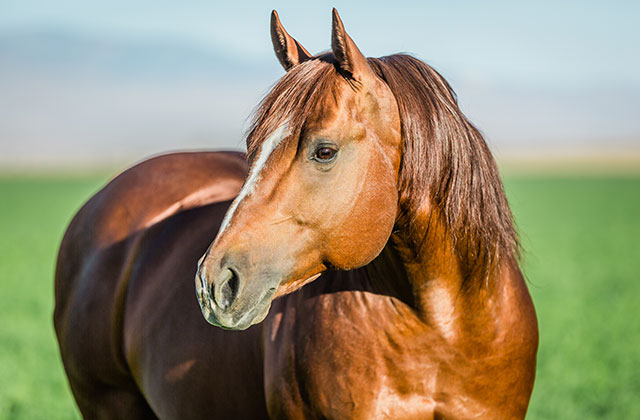
PHOTO BY NICOLE POYO
For Reproductive Supplementation Success:
Seasonal supplementation for stallions should begin 30 to 60 days before breeding begins.
Seasonal Supplementation Can Help
It is recommended for all horses, including stallions, to be provided a comprehensive daily wellness supplement to support general health. Specific seasonal supplementation should begin 30 to 60 days before breeding begins and be administered daily for best results. There are some well-documented supplemental ingredients that support breeding stallions and healthy sperm.
Omega-3 fatty acids provide many health benefits and are well-researched to support equine reproduction. Sperm have a high lipid (fat) content. Changes to this lipid composition may affect sperm physiology. Supplementing with omega-3 fatty acids may support healthy sperm quality, quantity and motility. They also support fertility by maintaining normal levels of specific inflammatory biological proteins that have a negative effect on testosterone. DHA, an algal omega-3 fatty acid, has been specifically shown to improve sperm motility in cooled and frozen semen.
Antioxidants, like alpha lipoic acid, selenium, and vitamins C and E, help to moderate or quench free radicals and offset oxidative stress. Excess free radicals may stress a stallion’s body and weaken immunity. Antioxidants are critical in the freezing and thawing process of sperm to support sperm viability. Antioxidants are important for every stallion, but supplementation will likely be necessary for those not on pasture and/or on a high-fat diet.
Carnitine is an effective antioxidant and provides additional benefits important for stallion fertility. It is required biologically for energy production and supports normal blood flow. Studies in horses show that carnitine intake has been positively correlated with sperm quality and supplementation promotes sperm progressive motility.
A comprehensive joint supplement with omega-3 fatty acids and antioxidants that provides joint-targeted nutrients like glucosamine, hyaluronic acid, MSM, cetyl myristoleate and ASU should be considered for breeding stallions. There is an elevated and consistent strain on joints and soft tissue, particularly on the hind legs. Joint pain may interfere with a stallion’s willingness to breed. Older stallions or those that breed extensively for many months may need supplemental support.
150-300
The range in number of mares a stallion may cover in a breeding season
20-25%
The increase in energy requirement above maintenance of breeding stallions
5-6
The ideal Body Condition Score to target for breeding stallions
1.5-2%
The percentage of a stallion’s body weight they should consume of quality forage
Breeding Season Podcast:
Hats Off to The Stallion
A conversation with Dr. Charlie Scoggin talking all things related to the management of breeding stallions, including genetics, transitioning stallions from performance to breeding and the importance of a whole-horse approach.
Listen
by Emily Smith, MS,
Platinum Performance®
You May Also Like
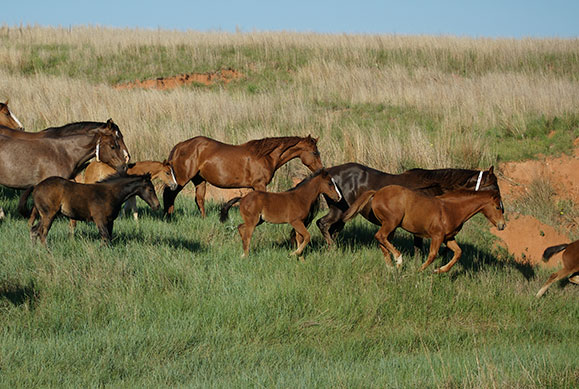
On the Front Lines of Life
An inside view of equine reproduction from Theriogenologists Dr. Elaine Carnevale, Dr. Dickson Varner, Dr. Charlie Scoggin & Dr. Jennifer Hatzel
Read More